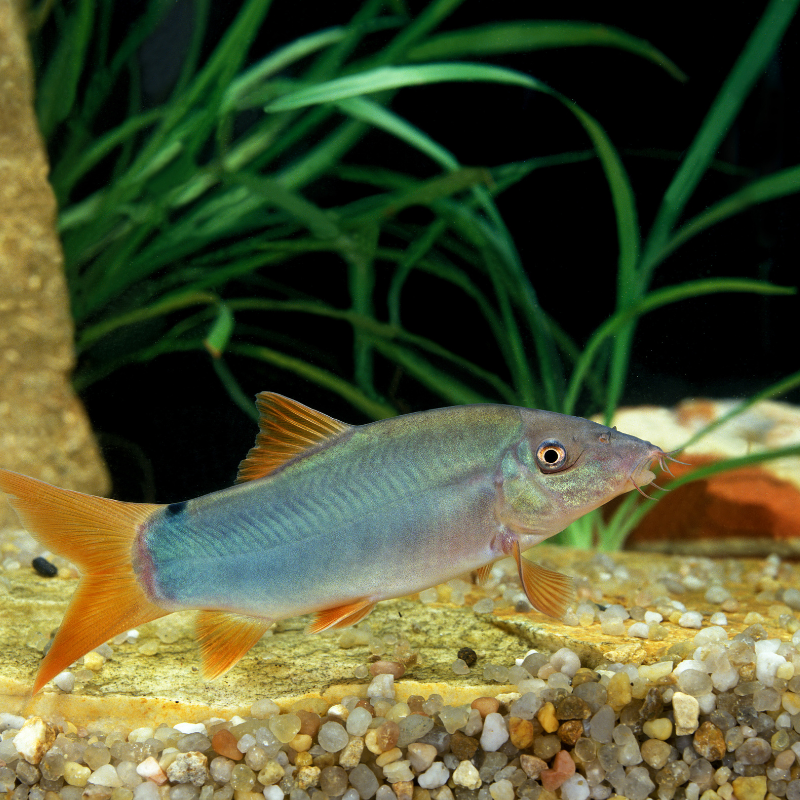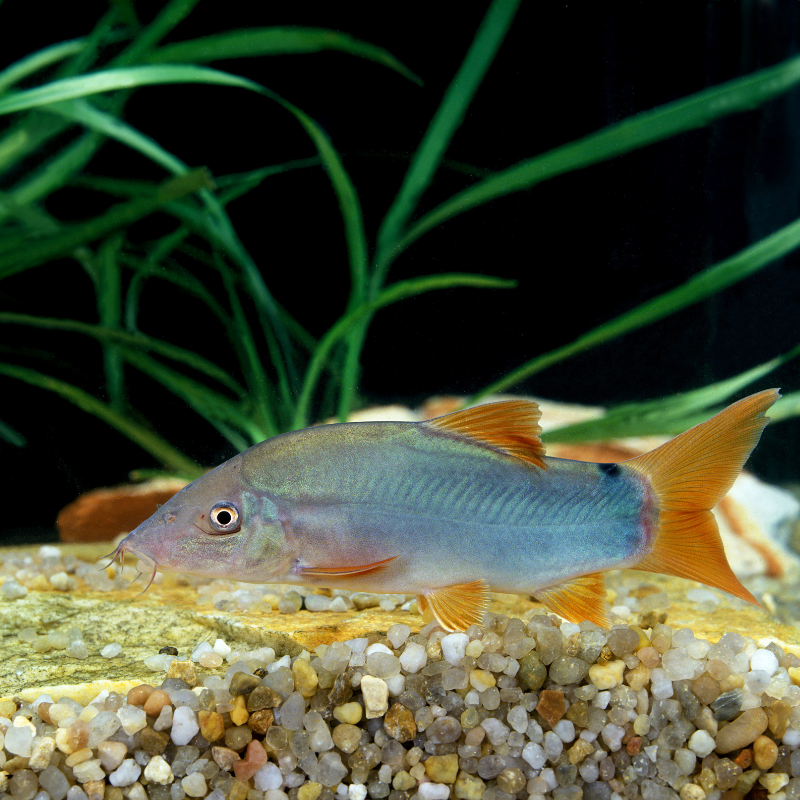Next working day delivery with Royal Mail Tracked 24
Description
Red Tail Botia,
Yashuhikotakia modesta, also known as the Blue Botia, is commonly distributed throughout much of the middle and lower Mekong basins in Thailand, Laos, Cambodia, and Vietnam plus the Chao Phraya and Mae Klong drainages in western and central Thailand. Red Tail Botia's are considered semi-aggressive and mildly territorial, but not anywhere near the Skunk Loach for aggressive behaviour. Red Tail Botia loach can be identified by their blue-black body colouring and orange fins. Red tail botia may also display a black dot on their backs above the tail.
The Redtail Botia Loach is a semi-aggressive fish that enjoys the company of its own species, or other semi-aggressive fish. It will school with other loaches of the same age and size. To encourage schooling, it is recommended that red tail loaches are kept in groups of 5 or more in a spacious aquarium in order for them to establish their territories. The fish tank habitat should have a softer substrate, like sand or fine gravel, to protect their sensory barbels. Construct an environment with plenty of hiding spaces, such as driftwood, rocks or bark, to ensure they can establish suitable territory. Red Tail Botia loaches will often burrow in the sand underneath rocks and bogwood.
Are Red Tail Botia loaches aggressive?
Redtail loaches are territorial and can be semi-aggressive towards other bottom feeders and low-level swimmers, although this is generally rare and unlikely to persist long term. Housing Red Tail Botia in groups will lower aggression. You can house Red Tail Loach with other semi-aggressive botia species (loaches) or bottom feeders such as corydoras or plecos, but avoid skunk loach as they are likely to threaten their territory.
Will Red Tail Botia Loach eat snails?
Yes the Red Tail Botia loach will eat snails, and also other crustaceans. Take care not to house Red Tail Loach with ornamental snails or shrimp, such as cherry shrimp. They will attack and eat snails of any size, including apple snails (large) and pest snails (small). They are commonly used to control pest snail levels in larger fish tanks.
Features
Approx. supplied size: 2" / 4-6cm
Maximum size: 10" / 25cm
Origin: Asia
Famil: Botiidae
Ideal number kept together: 5+
Temperament: Territorial, semi-aggressive
Water conditions
Our conditions: pH 7.5 temp 24°C
Ideal pH: 6.5–8.0
Hardness: 2-15 dGH
Ideal temperature: 24–30°C
Lighting: moderate
Water flow: high, well oxygenated
Ease of Care
Moderate. Redtail loach should be considered semi-aggressive and housed accordingly. A soft substrate is essential. They can also grow quite large, up to 10" inches, but in household aquaria they will typically reach only 7-8".
Diet
Omnivore. Red tail loaches are happy with catfish pellets, flake and granules, and will eat meatier live and frozen food occasionally to supplement. They will eat snails and other crustaceans, including shrimp.
Compatibility
Redtail botia can be territorial and semi-aggressive, but will shoal with other loaches of a similar size (although avoid skunk botia)
Breeding
Egg layers. Not commonly bred in captivity. Females tend to have a rounder body than males.
Life Span
Red Tail Botia Loach can live up to 5 years in perfect conditions.
Please note we cannot hand-pick male or female unless specified in the listing.
Photograph is for illustrative purposes intended as a guide to the species you will receive. Shades and patterns may vary.
For more information on general fishkeeping and our shipping procedures click here.
Shipping Cut Off Times
- In stock orders placed before on working weekdays before 2pm will be despatched on the same working weekday.
- In stock orders placed on a Saturday before 10am will be despatched on that Saturday.
- Orders that include pre-order items will be shipped together in total once the pre-order items arrive back in stock using the delivery service chosen at checkout.
None of these cut-offs apply to palletised items, pond plants or fibreglass ponds.
| SERVICE | SPEND | COST |
| Packet/Courier items | ||
| Royal Mail Next Day (1-2 days) | £0.00-£49.99 | £3.99 |
| DPD Local Next Day (1 day) | £0.00-£49.99 | £6.99 |
| DPD Local Saturday | £0.00-£49.99 | £14.99 |
| DPD Local Sunday | £0.00-£49.99 | £14.99 |
| DPD Local Next Day (1 day)*** | £50 and up | FREE |
| DPD Local Saturday | £50 and up | £9.99 |
| DPD Local Sunday | £50 and up | £9.99 |
| Pallets (booked in) | aquariums / bulky items | |
| Pallets Standard (3-5 days) | - | FREE |
| Pallets Express (1-2 days) | - | £39.99 |
| *EXCLUDED ITEMS | extra delivery fees apply | |
| Fibreglass Ponds (booked in) | ||
| Zone 1 (7-10 days) | - | £79.99 |
| Zone 2 (7-14 days) | - | £149.99 |
| Zone 3 (7-21 days) | - | £249.99 |
| Pond Plants (direct from grower) |
||
| All pond plants (3-10 days) | one-off fee regardless of order size/value | £5.99 |
***Orders with a value between £50 and £80 that are under 2kg in weight may be sent via a Royal Mail Next Day Signed for service.
Further delivery information
All delivery services are working day services and do not include delivery on Saturdays and Sundays or public holidays as standard.
Deliveries are usually Monday to Friday only, although some Royal Mail items may be delivered on weekends as standard if the service is available in your area.
Orders over £50 delivering to non UK mainland locations may be despatched via a Royal Mail (2-3 days) service rather than an express shipping option.
Please see our full delivery information page and terms and conditions for detailed information on shipping policies and zones


